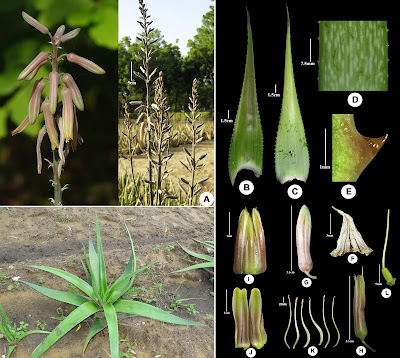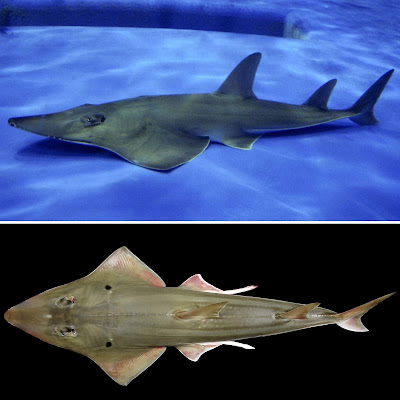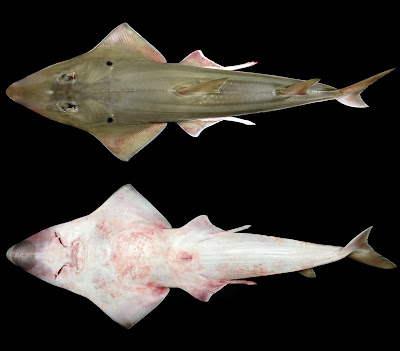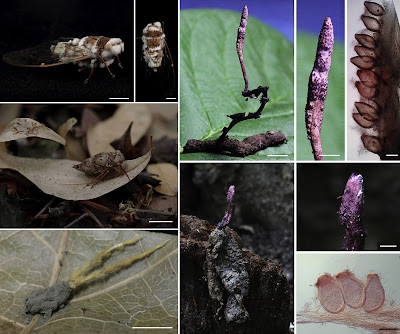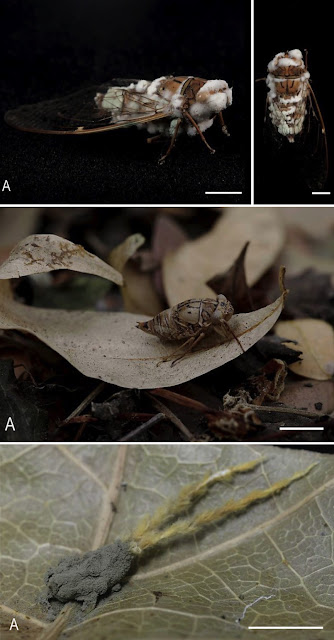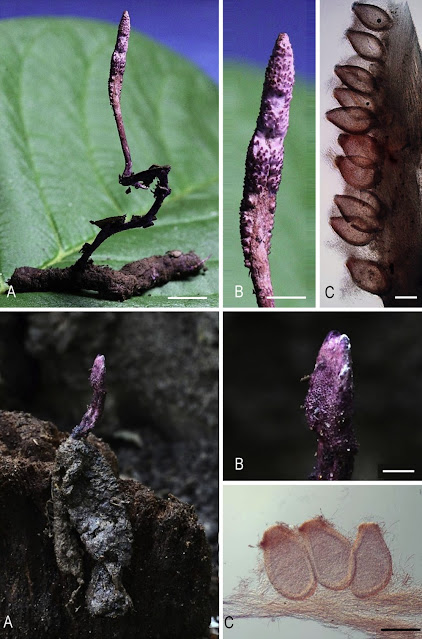[Most Recent Entries] [Calendar View]
Thursday, October 22nd, 2020
| Time | Event | ||||||||
| 4:22a | [Botany • 2020] Aloe trinervis (Asphodelaceae) • A New Succulent Species from Indian Desert
Abstract Keywords: Aloe, Asphodelaceae, Indian desert, New species, Rajasthan Aloe trinervis sp.nov. C.S. Purohit, R.N. Kulloli et Suresh Kumar Diagnostic characters. Aloe trinervis sp. nov. shows similarity with Aloe vera (L.) Burm.f. in having succulent, rosulate leaves, persistent floral bracts, free tepals and six stamens but differs in the recurved teeth on the leaf margins, 3-nerved floral bracts, branched inflorescence (90–95 cm long), flowers 31–34 mm long, flowers pale green with brownish at middle, and longer stamens (29–33 mm). Etymology. The species epithet trinervis refers to the three nerved floral bracts which are distinctive and unique to this new species. Distribution. The type locality of the new taxon is the protected area of Shivbari-Jorbhir area, Bikaner, Rajasthan. Conservation status. The new species is rare at the locality. Collected only from four different sites, the extent of occurrence is estimated to be less than 500 km2. So far, only a limited area of occurrence of this species has been found. Based on its area of occupancy and extent of occurrence of A. trinervis is assigned as “Endangered” (EN; criteria B1ab (i, ii) + B2ab (i, ii) at country level i.e. India). Detailed investigations are therefore needed to confirm its conservation status. Ecology. It occurred on sandy gravelly plain and rocky terraces associated with other plant species such as Acacia senegal, Acacia nilotica, Euphorbia tirucalli, Opuntia dillenii, Prosopis cineraria, Prosopis juliflora, and Commiphora wightii Suresh Kumar, C.S. Purohit and Ravikiran N. Kulloli. 2020. Aloe trinervis sp. nov.: A New Succulent Species from Indian Desert (Asphodelaceae). Journal of Asia-Pacific Biodiversity. 13(2); 325-330. DOI: 10.1016/j.japb.2020.03.001 New Aloe species discovered from a desert in northwestern India | ||||||||
| 4:59a | [Ichthyology • 2020] Rhynchobatus mononoke • A New Species of Wedgefish (Rhinopristiformes: Rhinidae) from Japan, with Comments on Rhynchobatus laevis (Bloch and Schneider 1801)
Abstract Rhynchobatus mononoke sp. nov. (Rhinopristiformes: Rhinidae) is described from mature male and female specimens from southern Japan. A juvenile specimen, newly born from a captive individual collected from Kagoshima, is also referenced (non-type). The new species can be distinguished from congeners by a combination of its obtusely wedge-shaped snout, bluntly rounded dorsal fins, first dorsal fin originating about level with the pelvic-fin origin, and the outer fold on the spiracle posterior margin more pronounced than the inner fold. Distinctive coloration of the new species included a black blotch, followed by a single white spot (rarely absent) posterodorsally on the middle of the pectoral disc, and a large black blotch covering the anterior half of the undersurface of snout. Distinct white spots distally on the pectoral disc to the middorsal area were absent. Most previous records of species of Rhynchobatus in Japanese waters were reidentified as Rhynchobatus australiae, except for the records from the northern East China Sea. Rhynchobatus mononoke appears to be endemic to southern Japan. Keywords: Rhynchobatus australiae, Rhynchobatus djiddensis, Rhynchobatus laevis, Taxonomy, Endemic species, East China Sea, Rays
Rhynchobatus mononoke sp. nov. (New English name: Japanese Wedgefish; new standard Japanese name: Mononoke-tongarisakatazame モノノケトンガリサカタザメ) Rhynchobatus djiddensis (not Forsskål 1775): Yamada et al. 2007: 94, pl. 5–5, (northern East China Sea); Kagoshima City Aquarium Foundation 2008: 32, fig. (Kagoshima, Japan, photograph of freshly captured individual); Kagoshima City Aquarium Foundation 2018: 37, fig. (Kagoshima, Japan, photograph of freshly captured individual).
Etymology. The specific name of the new species, mononoke - もののけ, means “specter” in Japanese, due to the ventral surface of specimens appearing like a traditional Japanese specter, wearing a triangular white hat (crown) on its forehead. The name is used as a noun in apposition. Keita Koeda, Masahide Itou, Morihiko Yamada and Hiroyuki Motomura. 2020. Rhynchobatus mononoke, A New Species of Wedgefish (Rhinopristiformes: Rhinidae) from Japan, with Comments on Rhynchobatus laevis (Bloch and Schneider 1801). Ichthyological Research. DOI: 10.1007/s10228-020-00777-z 「もののけ」が世に出ました Ray at Kagoshima aquarium revealed as new species | ||||||||
| 9:12a | [Fungi • 2020] Revisiting Metarhizium and the Description of New Species from Thailand Abstract Over the last two decades the molecular phylogeny and classification of Metarhizium has been widely studied. Despite these efforts to understand this enigmatic genus, the basal lineages in Metarhizium are still poorly resolved. In this study, a phylogenetic framework is reconstructed for the Clavicipitaceae focusing on Metarhizium through increased taxon-sampling using five genomic loci (SSU, LSU, tef, rpb1, rpb2) and the barcode marker ITS rDNA. Multi-gene phylogenetic analyses and morphological characterisation of green-spored entomopathogenic Metarhizium isolates from Thailand and soil isolates of M. carneum and M. marquandii reveal their ecological, genetic and species diversity. Nineteen new species are recognised in the Metarhizium clade with narrow host ranges: two new species are found in the M. anisopliae complex – M. clavatum on Coleoptera larvae and M. sulphureum on Lepidoptera larvae; four new species are found in the M. flavoviride complex – M. biotecense and M. fusoideum on brown plant hoppers (Hemiptera), M. culicidarum on mosquitoes, M. nornnoi on Lepidoptera larvae; three new species M. megapomponiae, M. cicadae, M. niveum occur on cicadas; five new species M. candelabrum, M. cercopidarum, M. ellipsoideum, M. huainamdangense M. ovoidosporum occur on planthoppers, leafhoppers and froghoppers (Hemiptera); one new species M. eburneum on Lepidoptera pupae; and four new species M. phuwiangense, M. purpureum, M. purpureonigrum, M. flavum on Coleoptera. Of these 19 new species, seven produce a sexual morph (M. clavatum, M. eburneum, M. flavum, M. phuwiangense, M. purpureonigrum, M. purpureum, and M. sulphureum) and asexual morphs are found in the remaining new species and also in M. sulphureum, M. purpureonigrum and M. purpureum. Metarhizium blattodeae, M. koreanum and M. viridulum are new records for Thailand. An alternative neotype for Metarhizium anisopliae is proposed based on multi-gene and 5′tef analyses showing that CBS 130.71 from Ukraine is more suitable, being from a much closer geographical location to Metchnikoff’s Metarhizium anisopliae. This isolate is distinct from the neotype of Metarhizium anisopliae var. anisopliae proposed by M. Tulloch from Ethiopia (ARSEF 7487). Six new genera are established for monophyletic clades subtending the core Metarhizium clade, including Keithomyces, Marquandomyces, Papiliomyces, Purpureomyces, Sungia, and Yosiokobayasia. Metarhizium carneum, M. aciculare, and M. neogunnii are combined in Keithomyces and one new combination for M. marquandii in Marquandomyces is proposed. Purpureomyces is introduced for species producing purple stromata including a new combination for M. khaoyaiense and two new species P. maesotensis and P. pyriformis. Papiliomyces contains two new combinations for M. liangshanense and Metacordyceps shibinensis. The genus Sungia is proposed for the Korean species M. yongmunense on Lepidoptera pupa and Yosiokobayasia for the Japanese species M. kusanagiense also on Lepidoptera pupa. A synoptic and dichotomous key to the accepted taxa is provided together with tables listing distinguishing morphological characters between species, host preferences, and geography. Key words: Biological control, Clavicipitaceae, Entomopathogenic fungi Taxonomic novelties: New genera Keithomyces Samson, Luangsa-ard & Houbraken Marquandomyces Samson, Houbraken & Luangsa-ard Papiliomyces Luangsa-ard, Samson & Thanakitpipattana Purpureomyces Luangsa-ard, Samson & Thanakitpipattana Sungia Luangsa-ard, Samson & Thanakitpipattana Yosiokobayasia Samson, Luangsa-ard & Thanakitpipattana New species: Metarhizium biotecense Luangsa-ard, Khonsanit, Thanakitpipattana & Samson, M. candelabrum Luangsa-ard, Mongkolsamrit, Thanakitpipattana & Samson, M. cercopidarum Luangsa-ard, Mongkolsamrit, Thanakitpipattana & Samson, M. cicadae Luangsa-ard, Tasanathai, Thanakitpipattana & Samson, M. clavatum Luangsa-ard, Mongkolsamrit, Lamlertthon, Thanakitpipattana & Samson, M. culicidarum Luangsa-ard, Khonsanit, Thanakitpipattana & Samson, M. eburneum Luangsa-ard, Noisripoom, Thanakitpipattana & Samson, M. ellipsoideum Luangsa-ard, Khonsanit, Thanakitpipattana & Samson, M. flavum Luangsa-ard, Mongkolsamrit, Thanakitpipattana & Samson, M. fusoideum Luangsa-ard, Mongkolsamrit, Thanakitpipattana & Samson, M. huainamdangense Luangsa-ard, Mongkolsamrit, Thanakitpipattana & Samson, M. megapomponiae Luangsa-ard, Tasanathai, Thanakitpipattana & Samson, M. niveum Luangsa-ard, Tasanathai, Thanakitpipattana & Samson, M. nornnoi Luangsa-ard, Khonsanit, Thanakitpipattana & Samson, M. ovoidosporum Luangsa-ard, Khonsanit, Thanakitpipattana & Samson, M. phuwiangense Luangsa-ard, Mongkolsamrit, Himaman, Thanakitpipattana & Samson, M. purpureonigrum Luangsa-ard, Tasanathai, Thanakitpipattana & Samson, M. purpureum Luangsa-ard, Mongkolsamrit, Lamlertthon, Thanakitpipattana & Samson, M. sulphureum Luangsa-ard, Khonsanit, Thanakitpipattana & Samson, Purpureomyces maesotensis Luangsa-ard, Noisripoom, Thanakitpipattana & Samson, P. pyriformis Luangsa-ard, Noisripoom, Himaman, Mongkolsamrit, Thanakitpipattana & Samson New combinations: Keithomyces acicularis (H. Iwasaki et al.) Samson, Luangsa-ard & Houbraken, Keithomyces carneus (Duché & R. Heim) Samson, Luangsa-ard & Houbraken, Keithomyces neogunnii (T.C. Wen & K.D. Hyde) Luangsa-ard, Thanakitpipattana & Samson, Marquandomyces marquandii (Massee) Samson, Houbraken & Luangsa-ard, Papiliomyces liangshanensis (M. Zang et al.) Luangsa-ard, Samson & Thanakitpipattana, Papiliomyces shibinensis (T.C. Wen et al.) Luangsa-ard Samson & Thanakitpipattana, Purpureomyces khaoyaiensis (Hywel-Jones) Luangsa-ard, Samson & Thanakitpipattana, Sungia yongmunensis (G.H. Sung et al.) Luangsa-ard, Thanakitpipattana & Samson, Yosiokobayasia kusanagiensis (Kobayasi & Shimizu) Samson, Luangsa-ard & Thanakitpipattana Neotype: Metarhizium anisopliae (Metsch.) Sorokīn Suchada Mongkolsamrit, Artit Khonsanit, Donnaya Thanakitpipattana, K. Tasanathai, W. Noisripoom, S. Lamlertthon, W. Himaman, J. Houbraken, R. A. Samson and J. Luangsa-ard. 2020. Revisiting Metarhizium and the Description of New Species from Thailand. Studies in Mycology. 95; 171-251. DOI: 10.1016/j.simyco.2020.04.001 |
| << Previous Day |
2020/10/22 [Calendar] |
Next Day >> |
